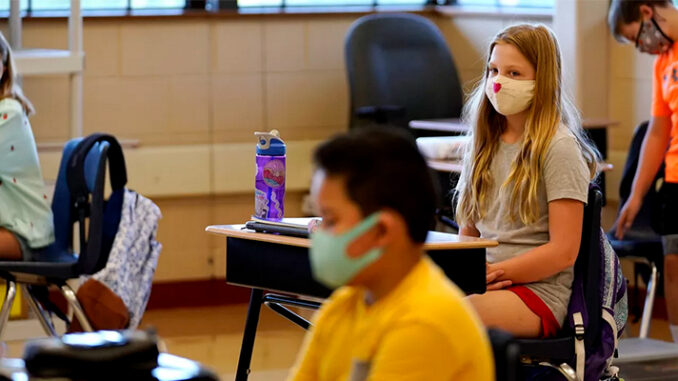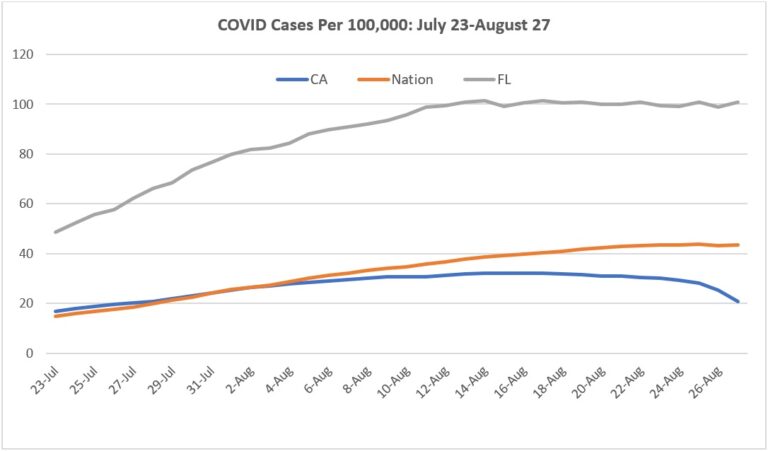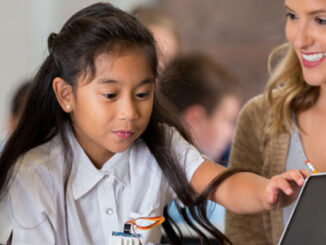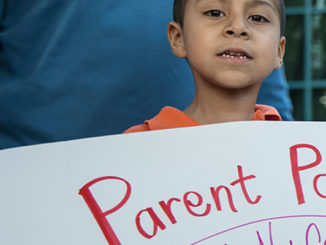
California’s rates remain significantly below the national average. Case rates here actually began declining in the last week while continuing to rise in most other states.
by Linda Darling-Hammond
California is launched on a new in-person school year just as the highly contagious Delta variant of Covid-19 is sweeping across the country.
Delta has certainly complicated the well-laid plans of our school leaders, as it required expanded testing and some quarantines but, in contrast to many other states, the path to opening schools in this state has shown promising results thus far — thanks to the focused efforts of principals, teachers, support staff, parents and students.
And, with continued vigilance and state policy support, the year promises to be even smoother in the coming months.
As of this week, our 20 largest districts, plus hundreds of smaller districts, will have opened on schedule. The remainder are on course to do so as well. While community-based infections have been identified by schools’ testing programs and required some quarantines as students return, schools have largely made the necessary preparations to manage those processes.
As just one example of the strong planning that has allowed safe reopening, Los Angeles Unified tested students on their way back to school, identifying about 3,250 positive cases of Covid-19 out of 350,000 tests (less than 1%). The district sent those students and their close contacts (another 3,000 students) home to quarantine under medical care, preventing community cases from becoming a source of more widespread quarantine within the school system.
Regular testing that can reduce infection, along with universal mask use and improved ventilation systems, will continue for students and staff to ensure a safe and stable school year. The large majority of parents and educators have voiced support and gratitude for these safety measures, as 97% of students have returned for in-person instruction.
This was made possible by the extensive planning of local leaders and by an intensive set of state supports designed to enable schools to safely engage in in-person instruction this school year in the face of the ever-shifting pandemic. Gov. Gavin Newsom, along with state public health and education leaders, has been laser-focused on providing the tools and resources that would be needed. In March, Newsom signed a $6.6 billion package to fund safety measures such as personal protective equipment, classroom ventilation upgrades and Covid-19 testing to help schools bring students back on campus.
In addition to funds for safety and prevention measures, the package included $4.6 billion to expand academic, mental health and social-emotional supports, including over the summer. As a result, 9 out of 10 districts offered summer school and expanded learning programs that helped students reengage with in-person learning and reconnect safely with each other and their teachers. Moreover, 98% of districts used those funds to kick off the school year with expanded mental health, after-school and learning supports, like high-dose tutoring.
Alert to public health signals about the coming wave of Delta, on July 12 California was the first state in the nation to issue a renewed masking mandate for all adults and children in schools. Sixteen other states have now done the same — most of them in the last week — as they were overwhelmed with Covid cases in their schools. On Aug. 11, California also became the first state to require vaccines or weekly testing of all school employees, on the heels of a similar requirement for all government workers. Now other states and large cities across the nation have begun to follow suit.
Since last spring, the state has at least partially vaccinated more than 80% of its eligible population. California has expanded outreach in multiple ways, including the deployment of vaccine vans for high-needs neighborhoods and school-located vaccine clinics for all who will host them. This can be an especially critical strategy for getting students vaccinated, given the important role that schools can play in encouraging parents to vaccinate their children.
The state also mounted a program to provide free Covid-19 testing to all schools and districts, including multiple options for the types of testing systems to meet community needs, and has distributed over 3 million testing kits. Nearly 700 of the state’s more than 1,000 districts have taken advantage of these programs to set up testing systems. School outbreak response teams offering testing and vaccine resources are being deployed to schools with the most acute challenges as schools deal with the cases that are coming in from the community.
By contrast, reopenings have been much more chaotic in states that have not embraced clear safety measures. Although schools have not yet opened in the Northeast and most of the Midwest, there have already been school closures for more than 700 schools in 158 districts across 25 states in the first two weeks. Most of these cases are coming in from the community.
But when schools do not engage in safe practices — attention to masking, ventilation, hygiene, testing, tracing and quarantining — transmission can occur within the building.
School Closings (As of 8/30/21, via Burbio)

Until last week, few states required universal masking in schools, and at least eight states had forbidden mask mandates despite evidence that Covid cases were rapidly climbing in camps and school settings where children — and many adults — were unvaccinated and unmasked.
Overall case rates, as well as pediatric hospitalizations, have grown rapidly in these states.
The situation is perhaps most challenging in Florida, where the governor not only banned mask mandates but threatened school funding and employees’ salaries if they required students to wear masks in school. Florida case rates and pediatric hospitalizations have climbed to a level more than five times greater than California’s, with no signs of improving.

https://covid.cdc.gov/covid-data-tracker/#compare-trends_comptrends-cases-daily-rate-log

Meanwhile, California’s rates remain significantly below the national average. Case rates here actually began declining in the last week while continuing to rise in most other states.
The path to a safe and stable school year depends on continuing to increase vaccination rates in all households, and on continuing safe mitigation practices in schools. Science shows that multilayered strategies such as masking; vaccination; testing and screening; handwashing; and ventilation are highly effective at preventing infection. Many studies have shown that in schools and child care settings where these rules have been followed, there is little or no transmission within schools, even when there are high rates of cases in the community as a whole.
In particular, masking is the most fundamental and effective tool against this airborne virus. In the countries that have kept their schools and societies open throughout the pandemic, masking has been a core strategy. It prevents transmission so well that, according to the Centers for Disease Control and Prevention and the California Department of Public Health, even when there is a case of Covid discovered, if the person infected and those exposed are all masked, quarantine is not needed if the exposed people are tested and remain asymptomatic. This, too, will support in-person instruction with minimal disruptions throughout the school year.
The surest path to safe and full in-person instruction throughout the school year is a strong emphasis on these reliable prevention measures: vaccines, masks, testing, tracing and ventilation. Currently, nearly half (46%) of California’s 12- to 17-year-olds are vaccinated, and concerted efforts can increase this number in the weeks to come. A vaccine for 5- to 11-year-olds is expected by early winter, followed within a few months by a vaccine for 2- to 4-year-olds.
As more of our districts hold vaccine clinics onsite for students and families, and as all of our schools continue their vigilance, Californians will be able to rely on safe schools, and we will likely see a continuing decline in case rates. While there will be many challenging moments ahead, California’s policies can continue to lead the way through this pandemic to a safer future that supports students’ learning and development, their relationships and friendships, their social and emotional well-being, and their educational progress.
Linda Darling-Hammond is president of the California State Board of Education and an adviser to Gov. Gavin Newsom.



